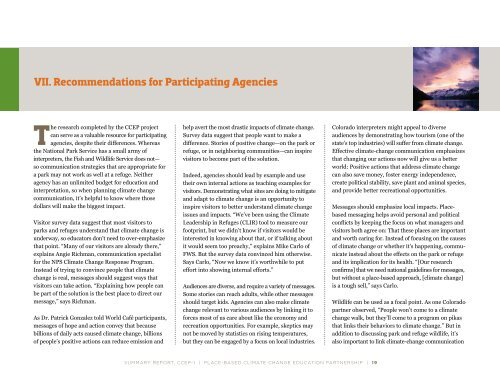Place-based Climate Change Education Partnership Report.pdf
Place-based Climate Change Education Partnership Report.pdf
Place-based Climate Change Education Partnership Report.pdf
You also want an ePaper? Increase the reach of your titles
YUMPU automatically turns print PDFs into web optimized ePapers that Google loves.
VII. Recommendations for Participating Agencies<br />
The research completed by the CCEP project<br />
can serve as a valuable resource for participating<br />
agencies, despite their differences. Whereas<br />
the National Park Service has a small army of<br />
interpreters, the Fish and Wildlife Service does not—<br />
so communication strategies that are appropriate for<br />
a park may not work as well at a refuge. Neither<br />
agency has an unlimited budget for education and<br />
interpretation, so when planning climate change<br />
communication, it’s helpful to know where those<br />
dollars will make the biggest impact.<br />
Visitor survey data suggest that most visitors to<br />
parks and refuges understand that climate change is<br />
underway, so educators don’t need to over-emphasize<br />
that point. “Many of our visitors are already there,”<br />
explains Angie Richman, communication specialist<br />
for the NPS <strong>Climate</strong> <strong>Change</strong> Response Program.<br />
Instead of trying to convince people that climate<br />
change is real, messages should suggest ways that<br />
visitors can take action. “Explaining how people can<br />
be part of the solution is the best place to direct our<br />
message,” says Richman.<br />
As Dr. Patrick Gonzalez told World Café participants,<br />
messages of hope and action convey that because<br />
billions of daily acts caused climate change, billions<br />
of people’s positive actions can reduce emission and<br />
help avert the most drastic impacts of climate change.<br />
Survey data suggest that people want to make a<br />
difference. Stories of positive change—on the park or<br />
refuge, or in neighboring communities—can inspire<br />
visitors to become part of the solution.<br />
Indeed, agencies should lead by example and use<br />
their own internal actions as teaching examples for<br />
visitors. Demonstrating what sites are doing to mitigate<br />
and adapt to climate change is an opportunity to<br />
inspire visitors to better understand climate change<br />
issues and impacts. “We’ve been using the <strong>Climate</strong><br />
Leadership in Refuges (CLIR) tool to measure our<br />
footprint, but we didn’t know if visitors would be<br />
interested in knowing about that, or if talking about<br />
it would seem too preachy,” explains Mike Carlo of<br />
FWS. But the survey data convinced him otherwise.<br />
Says Carlo, “Now we know it’s worthwhile to put<br />
effort into showing internal efforts.”<br />
Audiences are diverse, and require a variety of messages.<br />
Some stories can reach adults, while other messages<br />
should target kids. Agencies can also make climate<br />
change relevant to various audiences by linking it to<br />
forces most of us care about like the economy and<br />
recreation opportunities. For example, skeptics may<br />
not be moved by statistics on rising temperatures,<br />
but they can be engaged by a focus on local industries.<br />
Colorado interpreters might appeal to diverse<br />
audiences by demonstrating how tourism (one of the<br />
state’s top industries) will suffer from climate change.<br />
Effective climate-change communication emphasizes<br />
that changing our actions now will give us a better<br />
world: Positive actions that address climate change<br />
can also save money, foster energy independence,<br />
create political stability, save plant and animal species,<br />
and provide better recreational opportunities.<br />
Messages should emphasize local impacts. <strong>Place</strong><strong>based</strong><br />
messaging helps avoid personal and political<br />
conflicts by keeping the focus on what managers and<br />
visitors both agree on: That these places are important<br />
and worth caring for. Instead of focusing on the causes<br />
of climate change or whether it’s happening, communicate<br />
instead about the effects on the park or refuge<br />
and its implication for its health. “[Our research<br />
confirms] that we need national guidelines for messages,<br />
but without a place-<strong>based</strong> approach, [climate change]<br />
is a tough sell,” says Carlo.<br />
Wildlife can be used as a focal point. As one Colorado<br />
partner observed, “People won’t come to a climate<br />
change walk, but they’ll come to a program on pikas<br />
that links their behaviors to climate change.” But in<br />
addition to discussing park and refuge wildlife, it’s<br />
also important to link climate-change communication











